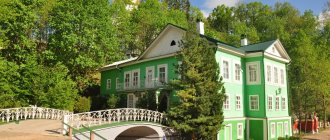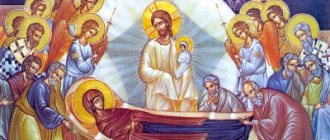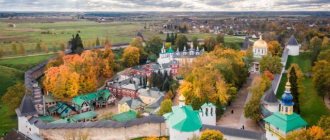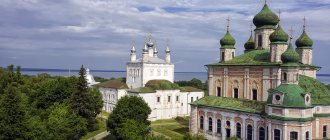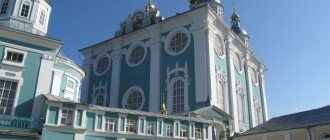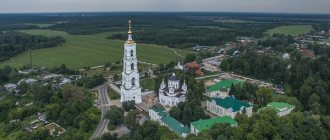From the history
One of the first hermits is considered to be a certain Mark. It was mentioned in the chronicle in 1932. Mark, like many of his co-religionists, fled here from the oppression of the Mongol-Tatars from the southern lands of Rus'. Together with several pilgrims, he settled in the caves. They are called “created by God” - that is, “created by God.”
Pskov-Pechersk monastery
Who knows, maybe these caves would never have been destined to become a great spiritual abode if the priest John and his wife had not settled here. It is this married couple that is considered to be the founders of the monastery. In 1470, Father John built the Church of the Assumption of the Holy Virgin in one of the dungeons. It was thanks to him that monks began to be buried in dungeons, without burying them in the ground.
By the way, at that time these territories belonged to a certain Ivan Dementyev. According to some sources, it was a simple peasant who used the territory as a clearing. Having learned about the settlement of pilgrims here, Dementyev abandoned his plot of land in their favor.
The heyday of the monastery is considered to be the middle of the 16th century, the time when the monastery was ruled by the Venerable Martyr Cornelius. One after another, new temples arose here under him, already above the surface of the earth.
The geographical position of the monastery - in the borderlands of Livonia - made it necessary for God's house to turn into a real impregnable fortress. She had to withstand more than one defense!
The Assumption Pskovo-Pechersky monastery is the only monastery in Russia whose activities were not suspended during the years of Soviet power, even in 1920, when the doors of absolutely all monasteries on the territory of the USSR were closed. The territories on which the Assumption Pskov-Pechersky was located were at that time transferred, according to the Tartu Peace Treaty, to independent Estonia.
During the Great Patriotic War, the monastery came under fire and bombing more than once; the walls of some churches were destroyed.
In January 1945, the territory on which the monastery is located became part of the RSFSR.
Today, the Assumption Pskov-Pechersk Monastery is a functioning monastery, the doors of which are open to visits by pilgrims.
Official website of the monastery: www.pskovo-pechersky-monastery.ru.
The last of the galaxy of great elders - Hodigitria
“On Saturday, April 28, in the 97th year of his life, Archimandrite Adrian (Kirsanov), the last of a galaxy of great confessors and elders who labored in the Pskov-Pechersky Monastery since the second half of the last century, reposed in the Lord. The Kingdom of Heaven and eternal memory to the servant of God Archimandrite Adrian!”
Archimandrite Adrian (Kirsanov) (1922 - 2018), resident of the Pskov-Pechersk Assumption Monastery (in the world Alexey Andreevich Kirsanov), was born on March 17, 1922 in the village of Tureika, Oryol Region, into a peasant family. He was left without a father early and grew up sick and weak.
One day, my mother, who had three children in her arms after the death of her husband, sent him to the city of Oryol to see a doctor. There was only one functioning church in the city at that time; Alexei entered it at the beginning of the liturgy and could not leave, feeling that it was his home.
Then he had a revelation: the Most Pure Virgin came down from the icon in front of which Alexei stopped, and the icon in Alexei’s vision was transformed into a battlefield.
Until 1941 he worked as a mechanic at a factory. When the Great Patriotic War began, he was evacuated to Taganrog to an airfield in a military town. Before the Germans occupied the city, he took part in the explosion of workshops. He made his way home, where he hid at home and in the forests with the partisans.
When his homeland was liberated by Soviet troops, he joined the army. Soon he ended up in Kolomna, where he guarded howitzer guns. Then the commission found he had a heart disease and Alexey was called to work at the Likhachev plant in Moscow. He worked there until 1953.
In 1953, he went to the Trinity-Sergius Lavra with the intention of joining the brethren. At first, the governor of the Lavra, Archimandrite John (Razumov), wanted to send the “simple” petitioner home, but then he relented and accepted him as a novice - to wash dishes.
He firmly held his place in the monastery. When his sick mother, reporting about the fire in which their house burned down, asked him to leave the monastery and earn money for a new house, he did not leave the laurels.
Important
Instead, he began to earnestly pray to St. Nicholas of Myra to help his sick mother.
Then they unexpectedly brought him a bag with money and an anonymous note - to give this money to the monk’s mother, whose house had burned down.
He served as a refectory attendant, then in charge of the production of candles.
During the Dormition Fast of 1957, he was tonsured a monk by the Lavra's abbot, Archimandrite Pimen (Izvekov), with the name Adrian. He was ordained a hierodeacon.
In 1970 he was ordained to the priesthood.
Soon after his ordination, he felt the ability to help those possessed by demons. He received the blessing of Patriarch Alexy I of Moscow and All Rus' for this. In the morning, crowds of insane, violent people, often abandoned by everyone, gathered under his cell. At 5 o'clock in the morning, Father Adrian confessed them, then read prayers expelling the evil spirit.
Through the care of Father Adrian, many were healed and transformed - they worked successfully and confessed Christ. However, his activities were not to the liking of many - both on the part of the atheistic authorities and on the part of envious people and guardians of the external appearance of the monastery.
After the incident, when, at the sight of Adrian’s father, a prominent American tourist suddenly became possessed, the leadership of the CPSU Central Committee issued an order “Remove Adrian from the Lavra within 24 hours.”
On August 26, 1975, he was transferred to the Pskov-Pechersky Assumption Monastery. Father had a hard time parting with his beloved monastery, he suffered a lot, and a peptic ulcer developed. But as soon as he began to recover, he again began to confess to the mentally ill.
He continued this ministry until 1990, then began to receive people who came for healing and advice, with worldly requests and troubles. There are known cases of his clairvoyance and miraculous healings through his prayers.
He continued his senile service even after reaching the age of 90.
From 1975 to 1978 - fraternal confessor of the Pskov-Pechersky Assumption Monastery.
In recent years, I spent a lot of time in prayer vigil and was silent.
Source: https://www.odigitria.by/2018/05/02/poslednij-iz-pleyady-velikix-starcev-pskovo-pecherskogo-monastyrya/
Legends and traditions
- There is a legend about why monks in caves are buried in open coffins and not buried in the ground. When the wife of Father John, the founder of the monastery, died, he buried her in a coffin at the entrance to the cave. He began to sing the funeral service. However, the coffin suddenly appeared from underground. John buried him again. The miracle happened again. Then the priest realized that this was an indication that he should be buried above the ground. He dug a niche for the coffin under the arch of the cave. Surprisingly, no bad odor emanated from the dead body over time. After this, all the monks who departed to the Lord began to be buried in caves in open coffins.
- The road between St. Nicholas Church and the Assumption Church is called the “bloody path.” According to it, according to legend, Ivan the Terrible carried in his arms the lifeless body of Abbot Cornelius, who he himself killed. If you believe the legends, the king inflicted a mortal wound on the abbot of the monastery, suspecting him to be a traitor, but then, having done something irreparable, he strongly repented.
- During the Khrushchev Thaw, the threat of closure hung over the Assumption Pskov-Pechersky Monastery. The abbot and monks - former front-line soldiers - gathered to defend their monastery with arms in hand, but not to allow atheists into the territory, ready to turn the house of God into ruins. However, there was no need to take up guns. Indira Gandhi visited the monastery. She became so emotional in the caves, looking at the faces of the departed holy fathers, and then shared her impressions with the political world community. A stream of tourist pilgrims, including foreign and high-ranking ones, poured into the “God-created” caves. The question of closing the monastery disappeared by itself.
- During the years when Alexander I ruled the Russian Empire, Lazarus performed the monastic feat in the Assumption Pskov-Pechersk Monastery, famous for the fact that his fate was similar to the fate of Lazarus of the New Testament. Like the last one, Lazarus of Pskov-Pechersk, having died, rose from the grave with the words “The death of sinners is cruel.” He lived another 16 years in continuous prayer.
Pskov-Pechersk elders and spiritual succession
Archimandrite Tikhon (Secretaryov), abbot of the Holy Dormition Pskov-Pechersky Monastery
Report at the XXII International Christmas educational readings , direction “Monastic tradition: from antiquity to the present day” (Sretensky Stavropegic Monastery. January 28–29, 2014)
Your Eminences, Your Reverences, viceroy fathers, brothers, mother abbess and sisters!
On behalf of His Eminence Eusebius, Metropolitan of Pskov and Velikoluksky, Holy Dormition Pskovo-Pechersk Monastery of the Holy Archimandrite, we greet you in connection with the upcoming festive events dedicated to the 700th anniversary of the birth of St. Sergius of Radonezh.
“I will build my Church, and the gates of hell will not prevail against it” (Matthew 16:18), said our Lord Jesus Christ, the founder of His New Testament Church. An integral part of the life of the Christian Church over the centuries has been monastic life in all its manifestations: hermitage, hermitage and communal forms. In confirmation of what has been said, it is enough to name the Monks Anthony and Theodosius the Great, Savva the Sanctified, Anthony and Theodosius of the Kiev-Pechersk, Sergius of Radonezh, the Wonderworker of All Russia.
“The spiritual tradition of Russian monasticism, largely formed under the influence of St. Sergius of Radonezh, has given abundant fruit in the field of the Lord...”, wrote His Holiness Patriarch Kirill of Moscow and All Rus' in his profound Message in connection with the 700th anniversary of the birth of St. Sergius of Radonezh. In the Holy Dormition Pskov-Pechersky Monastery it was read on January 26, 2014 during the Divine Liturgy.
Indeed, in the history of the Pskov-Pechersky Monastery there is spiritual evidence of the leadership of St. Sergius of Radonezh. The discovery of the caves created by God, where the ascetics lived led by the Venerable Hermit Mark, occurred in 1392, the year of the righteous death of the Venerable Sergius of Radonezh... Thus, the further formation of the Pskov-Pechersky Monastery is, as it were, a continuation of the ministry of the Venerable Sergius himself in the North-West of Rus' . And in the year of the 700th anniversary of the birth of St. Sergius, we celebrate the 100th anniversary of the birth of a pupil of the monastery of Abba Sergius - Archimandrite Alypius (Voronov), abbot of the Holy Dormition Pskov-Pechersky Monastery in 1959-1975.
Let's return to the Cathedral of the Pskov-Pechersk Reverends. Beginning from the 15th century, almost every century, saints were added to the Cathedral to the Venerable Elder Mark, a desert dweller of Pskov-Pechersk: the Venerable Jonah and Mother Vassa, builders of the Assumption Cathedral (1473); then the Venerable Martyr Cornelius, the forty-year-old constant abbot of Pskov-Pechersk, the builder of churches, the apostle of the Estonian Seto people (XVI century); Together with the Venerable Martyr Cornelius, according to legend, the Venerable Vassian, a learned monk and collector of the handwritten and printed patristic library of the monastery, also suffered; Rev. Dorotheos, envoy of the Pskov-Pechersk and founder of the Yuga monastery in the Yaroslavl diocese (XVII century). Continuing to name the saints of the Pskov-Pechersky Cathedral, let us name Elder Lazarus, who prayed earnestly to God and the Most Holy Theotokos in the 19th century for the salvation of Russia from the invasion of Napoleon and who twice received Emperor Alexander I in his modest cell. ), Bishop of Kharkov, who was abbot of the monastery in 1917–1919.
The named saints of Pskov-Pechersk and their associates revealed the will of God to the coming people of all classes of Russia and taught them to live according to the advice of the elders. To justify their ministry, they cited the words of our Lord Jesus Christ spoken to His disciples and apostles, and through them to all Christians: “He who listens to you listens to Me...” (Luke 10; 16). Also justification for the old man’s instruction are the words of the Wise One: “Salvation is in much counsel...” (Proverbs 11; 14).
In the 20th century, numerous devotees of piety glorified the Heavenly Mother Superior - the Most Holy Theotokos - and decorated the Pskov-Pechersk monastery with their lives. Among them: Hieroschemamonk Theodosius, who met the holy passion-bearers Tsar Nicholas II and Tsarina Alexandra at the monastery on August 5 (old style) 1903; Archimandrite Methodius (Kholmsky), rector of the Pskov-Pechersky Monastery at the beginning of the last century, who predicted his death in St. Petersburg and twice received the Holy Mysteries of Christ from the hands of the holy righteous John of Kronstadt; Valaam elders (among whom we name schema-abbot Luka, schema-monk Nicholas), who arrived at the Pskov-Pechersk monastery from Finland from New Valaam at the end of the Great Patriotic War and rested after their spiritual and educational works in God-created caves. The ascetics of that time spoke about spiritual life: “This is the science of sciences and the art of arts,” and about themselves they modestly added: “We are not scientists, but grounded.” Seeking the Kingdom of God in one’s heart, learning the Jesus Prayer, enduring all troubles and sorrows for the sake of Christ constituted the essence of their spiritual science.
There were also representatives of learned monasticism in the monastery, for example, Metropolitan Veniamin (Fedchenkov), who ended his life in the monastery and was buried in God-created caves, who left numerous written spiritual heritage. Currently, books by Bishop Benjamin have been published: “God’s People”, “Heaven on Earth” (about the Divine Liturgy and St. Righteous John of Kronstadt), “Notes of a Bishop”, “On Faith, Unbelief and Doubt”, “At the Turn of Epochs” and other. Bishop Veniamin’s opinion about the causes of the upheavals in Russia at the beginning of the 20th century, in the center of which he was at the center, is interesting: the loss among the intelligentsia, students, and army of faith in “the one Lord Jesus Christ, the Son of God, the Only Begotten, Who was born of the Father before all ages; Light from Light, true God from true God, born, uncreated, consubstantial with the Father, by Him all things were. For our sake, man and our salvation came down from heaven and became incarnate from the Holy Spirit and the Virgin Mary and became human. She was crucified for us under Pontius Pilate, and suffered and was buried. And he rose again on the third day according to the Scriptures." And in the Orthodox Church, according to the Bishop, there was a lack of holiness. Currently, hagiographic materials about Metropolitan Benjamin are in the Synodal Commission for the Canonization of Saints.
It is necessary to name other ascetics of piety of the 20th century in the Holy Dormition Pskov-Pechersky Monastery: schema-abbot Savva (Ostapenko), schema-archimandrites Pimen (Gavrilenko), Agapius (Agapov), Paisiy (Semyonov), Alexander (Vasiliev); Archimandrites Seraphim (Rosenberg), Feofan (Molyavko), Antipas (Mikhailov), Nikita (Chesnokov), Jerome (Tikhomirov), Nathanael (Pospelov) and many others who survived repressions and wars, which are briefly described in the book “Be Perfect”, compiled by us in 2008.
According to the words of the Apostle Paul (1 Cor. 15; 41), the monastic Simeon of Pskov-Pechersky and the elder Archimandrite John (Krestyankin) stood out as bright stars in the monastic and general church horizon in the 20th century.
The Monk Simeon of Pskov-Pechersk was canonized in 2003, and his holy relics are always available for veneration in the Sretensky Church, and by the faith of those who come to them, miracles and healings are now being performed by the Grace of the Holy Spirit: for example, numerous healings from tobacco addiction have been witnessed.
Elder Archimandrite John (Krestyankin), on his visit to the Monk Simeon of Pskov-Pechersk in 1955, received from him a blessing to continue his elder service in the monastery, which he fulfilled from 1967 to 2006. After the aforementioned first meeting, Saint Simeon called Father John “an earthly angel and a heavenly man...” Indeed, all of us who knew Archimandrite John testify to the fact that the priest had the gift of prudence - the main gift of an elder, the gifts of insight and healing... For all who seek salvation in Christ At present, it is useful to read the “Handbook for Monastics and Laity,” compiled by Father John, as well as a collection of letters from the elder... We have prepared a book about the pastoral ministry of Father John entitled “Christ’s Shepherd.”
In the preface to one of his books, published in 2005, Archimandrite John (Krestyankin) wrote a will, a fragment of which we will present for spiritual edification:
“And to you, as a request for prayerful memory of me, I leave these notes about life in God and a testament verified by my very life: My dear children of God! Believe God, trust His always good Will for us. Accept everything in life: joy, joylessness, prosperity, and evil - as the mercy and truth of the ways of the Lord. And fear nothing in life except sin. Only he deprives us of God’s favor and gives us over to the power of the enemy’s arbitrariness and tyranny. Love God! Love love and each other to the point of selflessness. The Lord knows how to save those who love Him.”
In continuation of the words of St. Sergius of Radonezh, “we will be saved by love and unity,” St. Seraphim of Sarov pointed out: “The goal of Christian life is the acquisition of the Holy Spirit.” Similar to the listed instructions of the saints, the words of Elder Archimandrite John (Krestyankin) sound, indicating in our difficult times the path to acquiring the Holy Spirit, to love and unity in the Lord: “The main thing in spiritual life is faith in God’s Providence and reasoning with advice...” By the way, It must be said that Father John also participated in the opening of the Holy Trinity Sergius Lavra after the Great Patriotic War.
Currently, under the blessed Protection of the miraculous icons of the Mother of God, including the copy of the image of the “All-Tsarina”, brought from Holy Mount Athos in 2002 by Archimandrite Ephraim, the tradition of eldership and spiritual care continues in the Holy Dormition Pskov-Pechersk Monastery. I will name several spiritual successors of the tradition of eldership: Archimandrite Adrian (Kirsanov); Schema-Archimandrite Nikon (Antonov), who was raised by the elder Archimandrite John (Krestyankin), starting with his service in the city of Kasimov, Ryazan diocese; fraternal confessor Archimandrite Tavrion (Balov), successor of fraternal confessor Schema-Archimandrite Agapit (Agapov); confessor and charter director Archimandrite Methodius (Leontyev), a student of Hierodeacon Anatoly (Semyonov), who was the charter director of the fraternal choir for many decades.
In order to indicate the main meaning of imitation of the elders in the matter of succession to spiritual care and shepherding, we cite the words of the Apostle Paul addressed to his contemporaries: “Imitate me, as I imitate Christ” (1 Cor. 4:16). Let us recall the words of our Lord Jesus Christ Himself, addressed to us: “Learn from Me, for I am meek and lowly in heart, and you will find rest for your souls” (Matthew 11:29). Thus, imitation of the elders and succession consists in the assimilation by their followers and disciples of the meekness and humility of Christ, and not the external “quiet speaking and bowed walk.” The other extreme is the replacement of healthy people, not burdened by family or other circumstances, with prayers and services in church only by listening to liturgical texts and prayers on electronic media. Thus, there is a danger of replacing real spiritual life with virtual addiction.
To preserve the continuity of eldership in the Holy Dormition Pskovo-Pechersky Monastery, His Eminence Eusebius, Metropolitan of Pskov and Velikoluksky, Holy Archimandrite of our monastery, passes on his rich spiritual experience acquired during communication with the elders in the Holy Trinity Sergius Lavra. Also, the vicar, confessors, dean and all the brethren in Christ make their modest efforts to preserve the continuity of counseling in the monastery. Eldership is not taught in church schools - it flows like precious ointment from vessel to vessel, from heart to heart by succession... Eldership of the Holy Dormition Pskovo-Pechersky Monastery is in demand in the 21st century as an integral part of serving Christ God by the Russian Orthodox Church.
Let me complete my brief report on the Pskov-Pechersk elders and spiritual succession with the words of His Holiness Patriarch Kirill of Moscow and All Rus', spoken at the opening of the XXII International Christmas Readings on January 27, 2014 at the State Kremlin Palace: “So, everyone who listens to these words of mine and fulfills them, I will liken him to a prudent man who built his house on the rock; and the rain fell, and the rivers overflowed, and the winds blew and beat against that house, and it did not fall, because it was founded on rock” (Matthew 7: 24-25). We must learn to apply these great Gospel words to our own life circumstances... we still live in the House, one of the great builders of which is St. Sergius.”
Thank you for attention!
09.02.2014
Social media
"God-given" caves
The underground complex includes near and far caves. The first ones are constantly open to pilgrims. To get to the distant ones, you need to agree in advance.
The founders of the monastery and those who stood at its origins are buried in nearby caves. The length of the gallery is 15 meters.
The distant ones are located on seven so-called underground streets. Their total length is more than 200 meters. Here are the open burials of more than 10 thousand deceased - both monks and pious pilgrims, defenders of the monastery.
The descendants of Modest Mussorgsky, Alexander Pushkin, and Mikhail Kutuzov are also buried here.
Unfortunately, the constant flow of pilgrims to distant caves may soon be stopped. The constant presence of living people provokes a rise in temperature in caves to +10-15 degrees. The ideal temperature for the incorruptible preservation of bodies is about +5 degrees.
Holy Caves
Cathedral of the Holy Fathers
On the Holy Mountain, not far from the entrance to the underground caves, a temple of the Pskov-Pechersk venerable elders was erected. The Assumption Pskov-Pechersky Monastery is famous for its wise holy fathers and ascetics like few others. There are a great many of them - they knew how to quench the thirst for spiritual quests, the pain of the hearts of the children who came to them, some were famous for their ability to perform miracles of physical healing. And such miracles, by the way, still happen to this day at the incorruptible relics of the holy elders.
One of the last most revered holy fathers, practically our contemporaries, is Father John Krestyankin. In 1970-90 Streams of pilgrims flocked to him for wise, insightful advice. The hard life, the years spent in the camps did not break his spiritual essence, on the contrary, they strengthened him, filled him with wisdom, patience and love, which the priest happily shared with everyone who came to him.
You can read more about one of the main attractions of Russia - the Holy Trinity Ipatiev Monastery here.
